Switch matrices are vital for applications where large numbers of signals received from various antennas and other sources are routed to receivers. The Crane Electronics Microwave Systems Model 1517 switch matrix is an ideal solution for installations where a number of antennas are being shared by numerous broadband receivers.

Switch Matrix Basics
Switch matrices are manufactured in a variety of configurations and sizes. Devices can range from very simple cross-point matrices to very large, multi-level units. The following is an explanation of various matrix configurations.
The simplest of switch matrix types is the blocking matrix. This type of matrix has a single or limited number of paths through the matrix, causing some inputs or outputs to be “blocked” in their ability to transfer signals. A simplified blocking matrix is illustrated in Figure 1. These offer the most economic and efficient approach as well as eliminating issues related to high frequency operation due to system impedances.

A block diagram illustrating a simple cross-point matrix is shown in Figure 2. This matrix provides the ability to connect each input to the three respective outputs. This type of matrix operates well at low frequencies. However, as the frequencies increase to RF and microwave ranges, maintaining proper impedances when different input/output combinations are selected, as well as configuring the matrices into larger units, becomes a challenge.
Adding complexity and additional through-paths, the matrix can be configured as a non-blocking distributed matrix, as illustrated in Figure 3. This configuration offers the ability to have a constant impedance and minimal unit insertion loss. The penalty is one additional switch crosspoint.
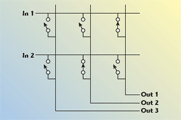
Adding more complexity in the form of power dividers, the switch matrix can be made a full fanout type. This type of matrix is illustrated in Figure 4. The advantage of this configuration is that any input can be simultaneously routed to all outputs. Introducing the power dividers adds loss in the signal path due to the signal split. In this case, amplifiers are usually added so that the loss can be overcome. The addition of the amplifiers further complicates the device and degrades the ability to maintain the ultimate signal purity. Compromises of compression point and signal intercept point are usually a trade off of size, power consumption and cost. The frequency response of this type of matrix becomes more of a challenge as the signal is now routed through more than just the passive switch. The power divider and amplifier characteristics significantly impact the frequency response and other characteristic performance of the matrix.
Most switch matrices built by Crane Electronics Microwave Systems are non-blocking, full fanout types. Non-blocking refers to the fact that when connecting multiple inputs there are enough internal signal paths so that all inputs can be connected to all outputs. Full fanout means that any one input can be connected to any or all outputs, simultaneously, without degrading the signal on another output.
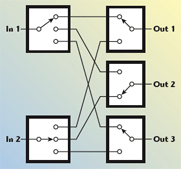
The model 1517 switch matrix is a full fanout non-blocking type of matrix. It contains power dividers and amplifiers, as illustrated in Figure 4.
Technical Implementation
The 1517 matrix offers a full fanout architecture. In addition, the unit provides exceptionally wide operating bandwidth with coverage as low as 1.5 MHz and as high as 1000 MHz. In order to achieve this wideband performance, the unit is actually separated into two separate operating bands. Since antennas do not usually cover this entire frequency spectrum, this unit is internally separated into an HF operating band (covering 1.5 to 32 MHz) and a VHF/UHF band (covering 30 to 1000 MHz). Amplifiers and power dividers optimized for each respective band are used as the input structure of the unit. At the output, wideband solid-state switches, covering the entire frequency range, are used. A block diagram illustrating the configuration is shown in Figure 5.
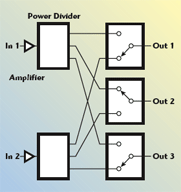
The design implementation for the model 1517 matrix uses a modular approach. The signal inputs are routed to amplifiers, which set the noise figure and overcome the losses of the subsequent power division and switch loss. The gain is set such that the overall gain of the unit is nominally zero in the HF band and –3 dB in the VHF/UHF band. The amplifiers used can either be for the HF band or of the VHF/UHF type. In the fully configured matrix with 16 inputs and 16 outputs, there are 256 switch crosspoints within the unit.
Following the input amplifiers, the signals are routed to the power dividers. These are 16-way Wilkinson power dividers, offering constant impedance for the inputs and outputs. The power dividers are fabricated using toroid transformer technology. Being 16-way dividers, these units have an inherent loss due to their 12 dB signal division. The HF divider is specified to have an additional signal loss of 1.5 dB above the 12 dB making a total of 13.5 dB loss. Similarly the VHF/UHF divider has 14.5 dB maximum total loss. The power dividers are configured with blind-mate SMB male connectors. The output connectors are configured such that they mate directly with the switch assemblies once installed in the unit chassis. They are arranged orthogonally such that the switches are fed in the arrangement indicated in the diagram.
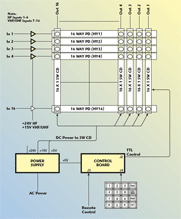
The switches are fabricated using conventional printed-circuit technology using PIN diodes as the signal control elements. Signal isolation is achieved using multiple sections of diode switching in a series-parallel configuration. This approach allows the unit to achieve 45 dB minimum isolation at the maximum operating frequency of 1000 MHz and 50 dB minimum at the HF operating range.
The unit is controlled using an embedded PC-based control architecture. The controller is based on an Intel Pentium MMX processor and utilizes a disk-on-a-chip for managing the operating system and executable instruction set. Control can be executed through the unit front panel or through a variety of remote control options, including RS-232 and 10/100 TCIP LAN. The commands are executed through establishment of a communications session with the matrix over the communications path. The connections are made through a series of strings that are transmitted to the unit. The command protocol is simple, commanding that a particular output be connected to a specified input. An established connection can also be broken by commanding the unit output to connect to input zero.
The controller is set such that when power is lost to the unit and the controller reboots, the last connection state will be restored. Additionally, the unit controller has a diagnostic mode in which power supplies and internal logic interfaces are evaluated. Upon completion of the diagnostic test, a report is returned indicating whether any faults are present.
Unit Performance

The Model 1517 achieves good RF performance over the operating bandwidth. RF gain is maintained within ±1 dB for the HF band. Additionally, over the HF band, the isolation is guaranteed to be 50 dB minimum. These performance points are illustrated in Figure 6.
Similarly, for the VHF/UHF band, the gain is specified at –1 ±2 dB and the isolation at 45 dB minimum. This performance is illustrated in Figure 7.
Noise figure for the unit is 8 dB maximum for the HF band and 10 dB maximum for the VHF/UHF band. Output intercept points are +18 dBm for the third-order and +40 dBm for the second-order. The unit is contained in a 4U, 19-inch rack chassis, 23 inches deep. It operates on a flexible 120 or 230 VAC with an auto-switching internal power supply. The unit is designed to operate in environmental temperatures from 0° to +50°C.
Conclusion
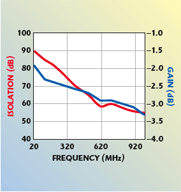
This new, highly flexible switch matrix unit is ideal for smaller signal reception installations. The model 1517 matrix offers the flexibility of having both HF band and VHF/UHF band input signals within the same unit. The inputs can be flexibly configured allowing for a different number of HF and VHF/UHF inputs depending upon the specifics of the location into which this unit is installed. Economies are achieved by allowing broadband receivers to be used covering both the HF and VHF/UHF bands, while maintaining band-specific antennas and therefore not compromising signal reception performance. The model 1517 switch matrix is a unique solution for reception site challenges.
Crane Aerospace & Electronics, Microwave Systems,
Beverly, MA (978) 524-7200,
www.craneae.com.
RS No. 301
